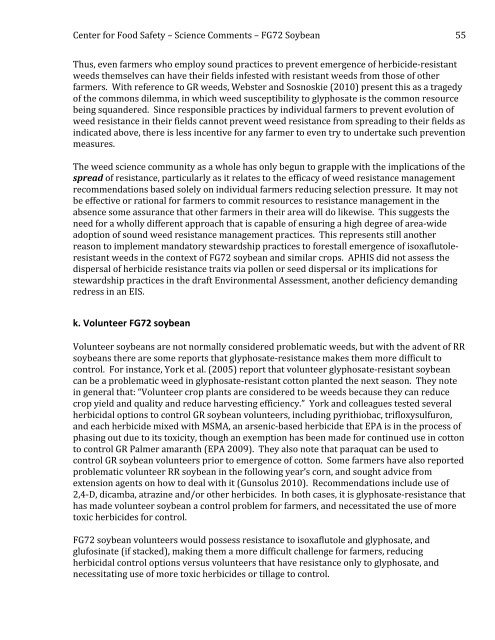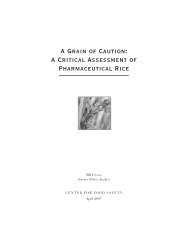a four-fold rise - Center for Food Safety
a four-fold rise - Center for Food Safety
a four-fold rise - Center for Food Safety
Create successful ePaper yourself
Turn your PDF publications into a flip-book with our unique Google optimized e-Paper software.
<strong>Center</strong> <strong>for</strong> <strong>Food</strong> <strong>Safety</strong> – Science Comments – FG72 Soybean <br />
55 <br />
Thus, even farmers who employ sound practices to prevent emergence of herbicide-‐resistant <br />
weeds themselves can have their fields infested with resistant weeds from those of other <br />
farmers. With reference to GR weeds, Webster and Sosnoskie (2010) present this as a tragedy <br />
of the commons dilemma, in which weed susceptibility to glyphosate is the common resource <br />
being squandered. Since responsible practices by individual farmers to prevent evolution of <br />
weed resistance in their fields cannot prevent weed resistance from spreading to their fields as <br />
indicated above, there is less incentive <strong>for</strong> any farmer to even try to undertake such prevention <br />
measures. <br />
The weed science community as a whole has only begun to grapple with the implications of the <br />
spread of resistance, particularly as it relates to the efficacy of weed resistance management <br />
recommendations based solely on individual farmers reducing selection pressure. It may not <br />
be effective or rational <strong>for</strong> farmers to commit resources to resistance management in the <br />
absence some assurance that other farmers in their area will do likewise. This suggests the <br />
need <strong>for</strong> a wholly different approach that is capable of ensuring a high degree of area-‐wide <br />
adoption of sound weed resistance management practices. This represents still another <br />
reason to implement mandatory stewardship practices to <strong>for</strong>estall emergence of isoxaflutole-resistant<br />
weeds in the context of FG72 soybean and similar crops. APHIS did not assess the <br />
dispersal of herbicide resistance traits via pollen or seed dispersal or its implications <strong>for</strong> <br />
stewardship practices in the draft Environmental Assessment, another deficiency demanding <br />
redress in an EIS. <br />
k. Volunteer FG72 soybean <br />
Volunteer soybeans are not normally considered problematic weeds, but with the advent of RR <br />
soybeans there are some reports that glyphosate-‐resistance makes them more difficult to <br />
control. For instance, York et al. (2005) report that volunteer glyphosate-‐resistant soybean <br />
can be a problematic weed in glyphosate-‐resistant cotton planted the next season. They note <br />
in general that: “Volunteer crop plants are considered to be weeds because they can reduce <br />
crop yield and quality and reduce harvesting efficiency.” York and colleagues tested several <br />
herbicidal options to control GR soybean volunteers, including pyrithiobac, trifloxysulfuron, <br />
and each herbicide mixed with MSMA, an arsenic-‐based herbicide that EPA is in the process of <br />
phasing out due to its toxicity, though an exemption has been made <strong>for</strong> continued use in cotton <br />
to control GR Palmer amaranth (EPA 2009). They also note that paraquat can be used to <br />
control GR soybean volunteers prior to emergence of cotton. Some farmers have also reported <br />
problematic volunteer RR soybean in the following year’s corn, and sought advice from <br />
extension agents on how to deal with it (Gunsolus 2010). Recommendations include use of <br />
2,4-‐D, dicamba, atrazine and/or other herbicides. In both cases, it is glyphosate-‐resistance that <br />
has made volunteer soybean a control problem <strong>for</strong> farmers, and necessitated the use of more <br />
toxic herbicides <strong>for</strong> control. <br />
FG72 soybean volunteers would possess resistance to isoxaflutole and glyphosate, and <br />
glufosinate (if stacked), making them a more difficult challenge <strong>for</strong> farmers, reducing <br />
herbicidal control options versus volunteers that have resistance only to glyphosate, and <br />
necessitating use of more toxic herbicides or tillage to control.







